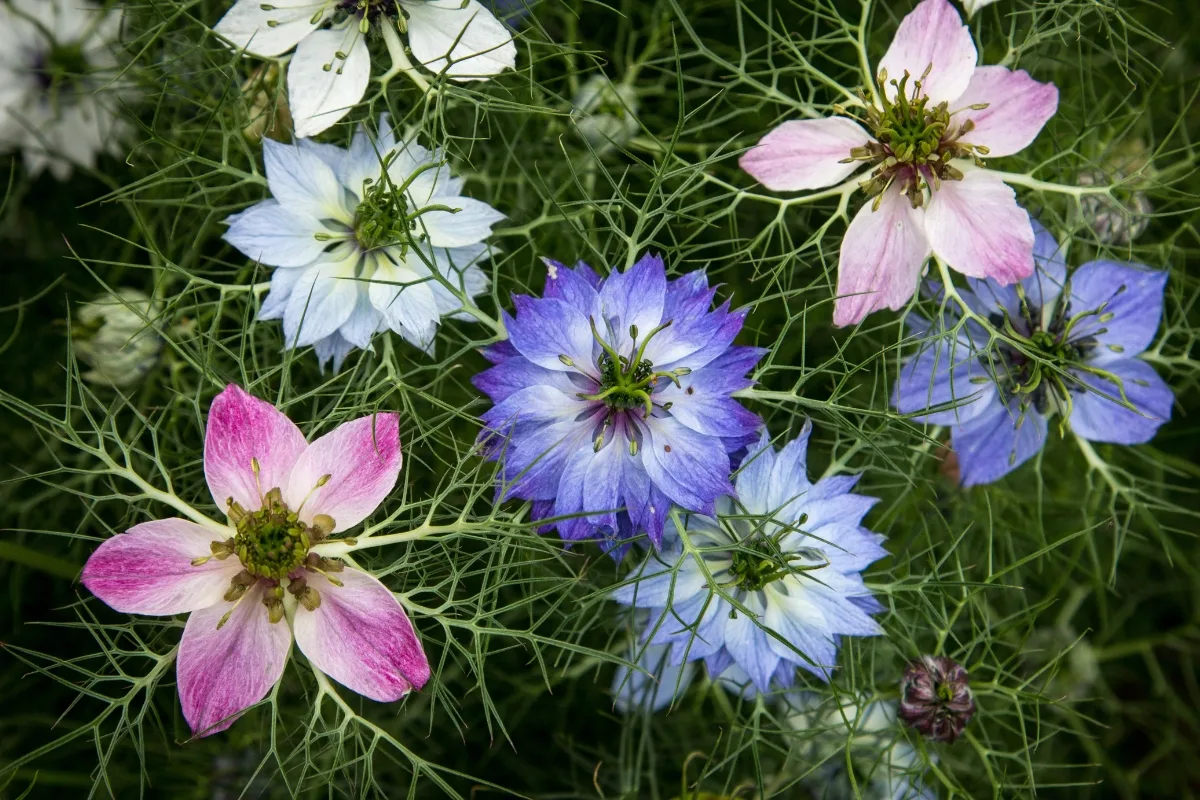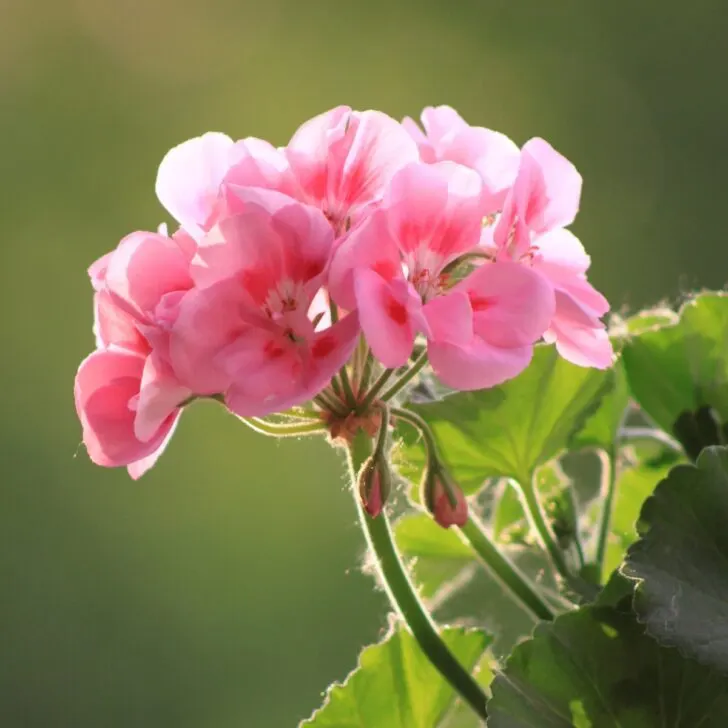Learn how to grow love-in-a-mist from seed! This airy plant, also known as nigella, adds unique blooms and foliage to any cottage garden.

Love-in-a-mist, also known as Nigella damascena, gets its name from the finely-toothed, frilly bracts surrounding the base of these charming flowers. The leaves look like fennel, and the attractive spring and early summer blossoms produce interesting seed pods.
Nigella belongs to the buttercup family, and it grows best in the cool weather of spring and early summer, declining as temperatures get hotter later in the season. It is a small, annual plant that grows to a maximum size of about 2 feet tall and wide.
Here's how to grow Love-in-a-Mist in your garden!

Nigella at a glance
| Common Names | Love-in-a-mist, Nigella damascena |
| Planting Time | Early spring or late summer/early fall |
| Seed Planting Depth | About ⅛ inch deep |
| Germination Time | 2-3 weeks |
| Seedling Spacing | 10 inches apart |
| Soil Type | Well-draining, fertile soil |
| Soil pH | Slightly acidic to neutral (pH 6-7) |
| Sun Exposure | Full sun to light, dappled shade |
| Size at Maturity | Up to 2 feet tall and wide |
| Bloom Time | Starts about 90 days after germination, lasts for 1-2 months |
| Temperature Preference | Cooler weather in spring and early summer |
| Additional Care | Deadhead spent flowers, thin seedlings to prevent overcrowding |
| Harvesting | For fresh cuts, remove lower leaves; for drying, harvest when pods show stripes and hang in a dry, well-ventilated area |
Love-in-a-Mist Varieties
You can find Nigella cultivars with different flower sizes, petal structures, and colors. For example:
- 'Miss Jekyll' has semi-double flower petals.
- 'Mulberry Rose' produces dark pink-colored flowers.
- 'Persian Jewels' is a series of cultivars with many shades, including light blue, purple, rose, white, and lavender.
- 'Oxford Blue' grows taller than many other varieties and has spectacular dark blue flowers, which is an unusual flower color in any plant.
- 'Orientalis transformer' has unique yellow flowers.

This year, I'm growing both Midnight Nigella from Baker Creek Seeds and African Bride from Floret in my cut flower garden. They'll be sown in the same bed as my cosmos seeds, since they both tend to self-seed and have a similar leaf texture.

How to Grow Nigella from Seed
Sowing outdoors
Nigella is really easy to grow from seed! Direct sowing is recommended, and has the best chance of success. You can also winter sow the seeds in milk jugs that are left outside to germinate and are transplanted out when the soil is workable.

For direct sowing, you can plant the seeds in early spring as soon as the soil is workable. You can also sow the seeds outdoors in late summer or early fall, and they will sprout up and flower early the following year.
I decided to try fall sowing Nigella seeds after preparing my raised beds for the winter. After putting down a layer of soil conditioner, I just sprinkled half of both packets of seeds on top and lightly covered them.

After a few weeks, I started to see little sprouts popping up! These tiny seedlings won't put on much growth over the winter, but will develop strong roots that will grow into gorgeous flowers in spring!

Thin the seedlings to a 10-inch spacing after they get two sets of true leaves. I plan to do this in the spring, so I can transplant the thinned seedlings to empty spots in the bed.
Sowing indoors
To start Nigella seeds early indoors, consider using a peat pot that can be transplanted along with the seedling to avoid disturbing the taproot.
Plant the seeds about ⅛ inch deep, and keep the soil evenly moist until the seedlings come up in two to three weeks.
Planting Love-in-a-Mist in the Garden
Choose a location with full sun or light, dappled shade in well-draining, fertile ground. Love in a Mist can grow in many soil types if it has a slightly acidic to neutral pH of 6 to 7.
Consider planting nigella in empty spaces in flower beds, as a bedding plant or in containers. Its fine-textured leaves and flower bracts combine nicely with other flowers and foliage in a cottage garden.

Nigella starts flowering about 90 days after germinating but only blooms for one to two months. Plant seeds in succession every three weeks or so in spring and deadhead spent flowers to keep it going.
Once it's growing, this plant requires little care except for keeping the soil consistently moist, although it has relatively low water requirements compared to some other flowering plants.

This flower readily self-sows, so once you get it growing, it's likely to spring back year after year without your help. Overwintered seeds will likely produce larger flower heads than those planted in spring. The seeds are so eager to sprout, this plant can become somewhat invasive if you don't deadhead spent flowers.
Caring for Love in a Mist Plants
Thin self-sown seedlings in the garden to prevent overcrowding of plants and deadhead spent flowers before the seed pods ripen unless you want to collect nigella seeds.

Few pests bother this plant, except aphids which can be easily removed with a jet of water from a garden hose or treated with insecticidal soap. Fungal diseases are the most common issue, which can be avoided by decreasing the amount of moisture on the leaves and providing adequate airflow.
Harvesting Nigella
The unusual flowers, foliage, and seed pods also make this an outstanding cut flower that lasts a long time in a vase. The seeds are also edible and can be used in cooking.
When harvesting nigella as a fresh-cut flower, remove the leaves on the bottom third of the stem before putting it in water. To dry seed pods and flowers, harvest them when you can see stripes on the pods and hang them upside down in a shady, dry, and well-ventilated location until they are dehydrated.

The black, aromatic seeds are often used as a flavoring in Indian and Middle Eastern cooking. You can use nigella in the kitchen as a substitute for black sesame seed, caraway seed, and cumin.
Do you grow love-in-a-mist in your own garden? I'd love to hear your experiences with this plant in the comments below!
Check out these other flowers you can start from seed!






